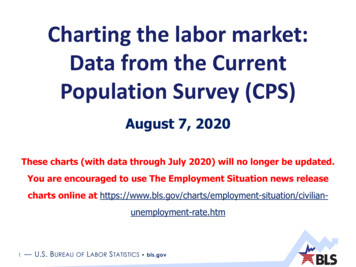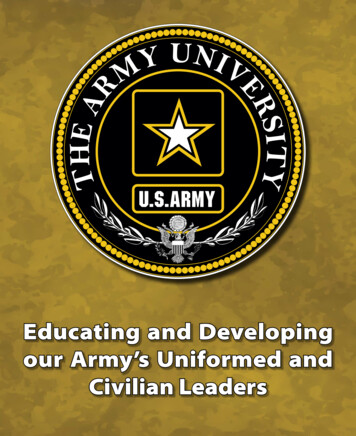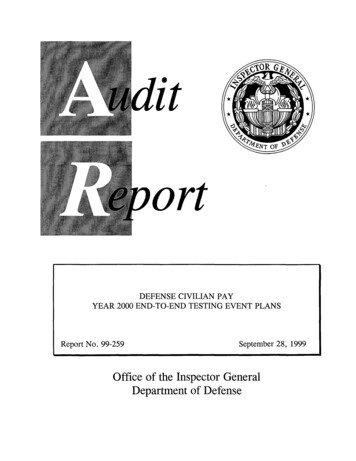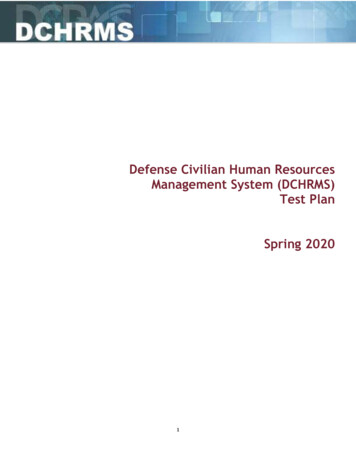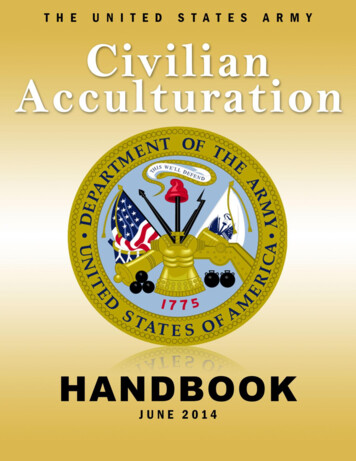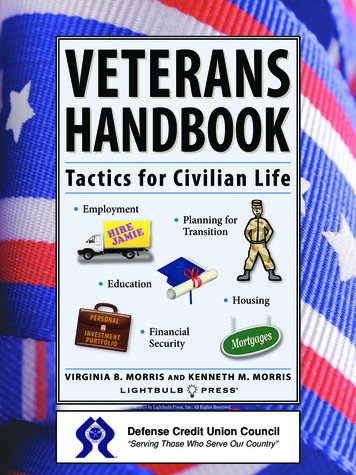
Transcription
Tactics for Civilian Life Employment Planning forTransition Education Housing FinancialSecurityV I R G I N I A B. M O R R I SANDK E N N E T H M. M O R R I S 2015 by Lightbulb Press, Inc. All Rights Reserved.Defense Credit Union Council“Serving Those Who Serve Our Country”VEHA
CONTENTS24681012141618Making the Right MovesMoving Out, Moving OnTransition AssistanceEmployment PlanningThe Job SearchThe Post 9/11 GI BillMaking Education ChoicesBuying a HomeShopping for a Loan 2015 by Lightbulb Press, Inc. All Rights Reserved.202224262830323436Life InsuranceHealth InsuranceManaging MoneyUsing CreditSaving and InvestingLong-Term PlanningInvestment StrategyOn Your GuardTelephone ContactsVETEHAND
VETERANS HANDBOOKMaking the Right MovesThere’s no basic training for new veterans.You’ve heard it before: The transition from servicemember to civilian is one of the most difficultyou’re ever likely to make. You can plan diligently,make well-reasoned decisions, and think you’reready for what’s ahead. But being a member ofthe military one day and a veteran the next meansleaving behind a clearly defined and closely knitunit and becoming just one of the crowd.How easily you manage this move depends onhow carefully you plan and a number of otherfactors, some of which you’re already aware of: Whether you made the decision to leavethe military or it was made for you If you have a good job lined up If you’re coping with a serious injury How stable your personal life iseducational institutions isn’tnecessarily veteran-specific, itcan help make it possible for youto be a full-time student.When you’re ready to buy ahome, you’ll want to investigate theVA home loan program and look intoreal estate tax breaks that may beavailable. Similarly, your insuranceneeds—life and healthcare inparticular—may be met at least inpart by programs you’re eligible foras a veteran.Finally, it’s smart to seek out veteranfriendly financial institutions for yoursavings, checking, and investment needs.But you may also have to cope with emotions orreactions that surprise or disturb you, includingsymptoms of persistent stress.The best way to prepare for this dramaticchange in your life is to anticipate its challengesand be ready to seize its opportunities.To prepare for the immediate choicesyou’ll have to make as a new civilian,it helps to group them into threecategories:OFF TO A HEAD START Career decisions, includingBefore you leave the service, it’s a good idea toidentify the professional, financial, and personalchoices that lie ahead and to explore the waysyour status as a veteran may give you certainadvantages.Certainly employment is a major concern,and, as you’ll discover, various departmentsof the federal government, including Defense(DoD), Labor (DOL), and Veterans Affairs (VA)have mounted a coordinated effort to help youlaunch a successful job search. Individual statesalso have veteran-specific employment programs,as do some private organizations.The Post 9/11 GI Bill provides tuition andhousing assistance for qualifying veterans.And while financial aid from the Departmentof Education, individual states, and many2 2015 by Lightbulb Press, Inc. All Rights Reserved.THREE KEY DECISIONSwhether to postpone your job searchto polish your skills, acquire newones, or finish an undergraduate orgraduate degree
VETERANS HANDBOOKFAMILY MATTERSIf you have a family—spouse, partner,children—the changes in your life areintertwined with the changes in theirs.Talking things through and makingcollaborative decisions are essential toa successful transition.For example, choosing one job overanother may be a decision you have to make for yourself. But where that job islocated, whether you buy a home right away or decide to rent, and if you choose touse the GI Bill’s tuition assistance for yourself, your spouse, or your children isn’tjust about you—they affect your family directly.If you’ve been deployed for extended periods, you and your spouse maynot have been doing much joint decision making, if only for practicalreasons. Establishing—or reestablishing—a partnershipapproach to setting goals, making choices,and managing money can add positiveenergy, rather than more stress,READY, AIM, FILEto your new life. Financial decisions, including establishing a relationship with areputable financial institution, suchas a credit union, setting a strategyfor saving and investing, and refiningyour money management skills Personal decisions, includingwhere to live, the type and amountof life insurance you need, and thebest source for health insuranceThere’s overlap, of course. The flexibility you have in managing your moneydepends on what you earn and whatyour living expenses are. Similarly, thedecisions you make about health insurance may depend on whether or notyour new employer offers this coverage. 2015 by Lightbulb Press, Inc. All Rights Reserved.If you plan to take advantage of the VAbenefits to which you’re entitled, it’s essentialto enroll for your VA eBenefits account atwww.eBenefits.va.gov.Check out the “Introduction to eBenefits”link on the Help Page for a description ofhow to apply. You’ll need to be registered inthe Defense Enrollment Eligibility ReportingSystem (DEERS) and have a DoD Self Service(DS) Logon.When you leave the military, the one thingyou don’t leave behind is the paperwork.There’s a form for almost everything, fromyour Release or Discharge papers (DD Form214) and Verification of Military Experienceand Training (DD Form 2586) to the specificdocuments you need to qualify for a VA loanguaranty, receive tuition assistance throughthe GI Bill, or convert your SGLI insurance.It’s smart to obtain the original documentsand a number of certified photocopies whileyou’re still on active duty. You will need a system for keeping them secure and accessibleso you’ll have them when you need them—which may be more often than you think.You’ll also want to keep careful trackof your personal records, including birthcertificates, adoption papers, marriagelicenses, and divorce decrees. There aretimes when you need originals, not copies.
VETERANS HANDBOOKMoving Out, Moving OnThere are ways to smooth your transition when you hit bumps inthe road.If your transition to civilian life were simply abouta change of address and a new job description, itwouldn’t be such an ordeal. But as millions of menand women before you have discovered, there’s alot more to transition than you might think—forboth you and your family.OPPORTUNITIES FOR SPOUSESIf your spouse isn’t a member of the military andeligible for transition assistance and veteransbenefits, he or she may find it difficult to makepersonal and career decisions, especially if you’restill sorting out your own future.MORE RESOURCESIn addition to the extensive resourcesavailable through the DoD, DOL, VA,ED, and other federal departments,there’s an extensive list of veteransorganizations, including some withspecialized missions, at www.veteransnetwork.net/directory.php.Other valuable transition resourcesare available on the websites of theNational Resource Directory (www.nrd.gov), the Iraq and Afghanistan Veteransof America (www.iava.org), and MilitaryExits (www.militaryexits.com).4 2015 by Lightbulb Press, Inc. All Rights Reserved.Spouses are eligible to attend the transitionworkshops and job fairs that are available to you.However, access to many of the spouse-focusedcareer and education programs, includingtuition assistance available through the MyCAAprogram and the Military Spouse EmploymentPartnership (MSEP), ends when you’re no longeron active duty.If your spouse has a scholarship through theNational Military Family Association, or othereducation or training benefits, it’s smart toinvestigate what effect, if any, your leaving theservice will have on continued participation inthe program and if any action is required.Remember, you do have the right to assign theeducation benefits to which you’re entitled underthe Post 9/11 GI Bill to your spouse or children,rather than using them yourself. But you mustmake that decision while you’re still on activeduty and meet other conditions that apply.MOVING OUT/MOVING ONThe DoD covers the expense of moving yourhousehold from your last duty station.If you’re leaving the service voluntarily, theDoD will pay for the move within 180 days of separation, provided you return to your home of recordor move somewhere that’s an equal or shorterdistance. If your new home is farther away, you’reresponsible for the additional cost of the move.If you’re leaving the service involuntarily, the
VETERANS HANDBOOKdistance limits do not apply to your moving costsand the time limit is extended to one year.FIGHTING OTHER BATTLESDespite your best planning and the help availableto you from a number of sources, not everythingmay go as smoothly as you’d like. One area ofpotential frustration is in obtaining benefits towhich you believe you’re entitled—disability inparticular, but also healthcare, education, andothers—if the VA turns down your claim.If you appeal and are again turned down, thereis a process for taking your case to the US Courtof Appeals for Veterans Claims. You can find information on how to file at www.uscourts.cavc.gov.One caution, however: You should alwayshave legal representation for court filings, andthe attorney you use must be accredited by theVA. You can search at www.va.gov/ogc/apps/accreditation/ either by typing in an attorney’sname or downloading a complete list.If you can’t afford a lawyer, you can contactthe Veterans Consortium Pro Bono Programat www.vetsprobono.org. The consortium’spartners are The American Legion, the DisabledAmerican Veterans, the National Veterans LegaliServices Program (NVLSP), and the ParalyzedVeterans of America.DEALING WITH STRESSIf transition is more difficult than you expected,don’t assume that the issues you’re facing willresolve themselves if you just give them enoughtime. Some may, if the stress is created byconcerns about landing a job, choosing a school,or buying a home.But if your experiences in a combat zone areweighing on you or you’re feeling adrift in civilianlife, it’s much wiser to seek help, both for yourown sake and the sake of your family.Online resources are often the most accessibleway to get started, including establishing ties witha community of other veterans. You might beginwith the websites www.maketheconnection.net,and the National Resource Directory atwww.nrd.gov and search for vet Success.You’ll also want to investigate the VA’s VETCenter Program (www.vetcenter.va.gov), whichprovides counseling for combat veterans andthose who experienced sexual trauma andharassment while on duty. It’s communitybased, free of charge, open to families as wellas veterans, and staffed by combat veterans andfamilies of combat veterans. There’s a directoryon the site, under the Locations tab at the top,where you can search for a center by state or zipcode, and a Combat Call Center open 24 hoursat 877-927-8387.You can also find a link to individual stateDepartments of Veterans Affairs at www.va.gov/statedva.htm. These offices may provide thein-person help you are looking for closer tohome and more quickly than the VA.IN AN EMERGENCYA Military Crisis Line at800-273-8255 provides trainedprofessionals available to takecalls at any time. Dial and then press “1”to connect. There’s also a chat feature atwww.veteranscrisisline.net or text 83-8255.5 2015 by Lightbulb Press, Inc. All Rights Reserved.
VETERANS HANDBOOKTransition AssistanceIt’s your job to take the initiative in finding the information you needand acting on it.You may find it hard to concentrate on becoming acivilian whether or not you’re still on active duty.The danger is that waiting too long to get startedon transition planning may force you into choicesthat may not be the best for you.A good first step is deciding where to begin.The most important are likely to include:FORWARD, MARCHThe Department of Defense (DoD) TransitionAssistance Program (TAP) and its website atwww.dodtap.mil are designed to smooth the pathto the next phase of your life.The easiestE FtoITsetS things in motion isBENwayto visit the TAP site—as well as your branch’stransition website—to explore the servicesthat can help ensure you’re ready to moveinto civilian life with the skills you need to besuccessful, whatever you choose to do next.TIPCheck out the valuable transitionassistance at Military OneSource(www.militaryonesource.mil) by clickingon the Transition Assistance link underMilitary Life Topics. You can also download. . . . . . . . . . . . . . . . . . . . . . . . . . . . . . . . . . . . . . . . . . .ofa copy“Federal Benefitsfor Veterans,. . . . . .and Survivors” at.Dependents,www1.va.gov/OPA/publications/. . . . . . . . .benefits book.asp6 2015 by Lightbulb Press, Inc. All Rights Reserved. The benefits to which you’re entitled as aveteran and how to obtain them Employment-related issues, specifically finding a job that’s the beginning of arewarding career Education opportunities for building yourskills or acquiring academic credentialsTAP’s core five-day Transition GPS—anacronym for goals, plans, success that youmay want to think of as your personal globalpositioning system—includes a financialplanning and budgeting component, a VA benefitsbriefing, and an employment workshop offeredin collaboration with the Department of Labor(DOL). You may also want to participate in oneor more of the supplemental training tracks thatfocus on higher education, technical training, orentrepreneurship.By the time you finish the program, andbefore you leave the military, you must beable to demonstrate that you have a workableIndividual Transition Plan (ITP) and have metthe required career readiness standards (CRS)detailed at www.dodtap.mil/career readinessstandards.html. You can find an ITP checklist,DD Form 2958, at f.
VETERANS HANDBOOKFITTING FORMSDD Form 2648A minimum of 90 days before you’re scheduled toleave the military, you’re required to complete DDForm 2648, the “Pre-Separation CounselingChecklist.” This multi-page document lets youcheck off the topics, if any, you’d like to discusswith a career counselor and the workshops andbriefings you’d like to attend.The form provides website links where youcan access information about each item in thelong list of choices. It’s up to you to determinewhat you need to know, what you can learn onyour own, and when counseling would help. Tomeet with a counselor, you must also be willingto indicate that you need help—not always theeasiest, but often the smartest, thing to do.You are also eligible for educational and vocational counseling from the Department of VeteransAffairs (VA) within 180 days of the date you expectto leave the service or within a year after actuallyleaving, provided you are eligible for a VA education program. To sign up, you use VA Form28-8832, “Application for Counseling.”To participate in any programs offered throughthe VA, as well as many of the federal and stateveterans programs, you’ll need a copy of yourDD Form 214. In fact, you should be sure yourlocal Veterans Center has a certified copy of theform on file in case you need to provide it in thefuture. After you leave the military, this form andyour military records are stored in the NationalArchives. You have access to them, but gettingreplacement copies can be very slow.The hands-on DOL employment workshopis a focal point of transition program. Itincorporates the use of social media andother networking technology to facilitatejob searches and provides access to prioritycareer guidance and job search services.Part of the three-day workshop focuseson practical matters, including writingresumes and cover lettersand honing interview skills.The workshop also deals withmore open-ended issues,such as choosing amongjob offers and adjusting toa civilian workplace. You canalso expect the facilitators toprovide an evaluation of yourstrengths and weaknesses asa job candidate.The workshops are presented on some, but not all,military installations. Ask theTransition Assistance Office at your Camp,Post, or Station, or your Command CareerCounselor to help you schedule a slot. Ifthere’s space, your spouse may also beeligible to participate to facilitate his or herown job search.If you can’t be there in person, you canuse the link on the Transition GPS homepageto access the virtualcurriculum at the JointKnowledge Online (JKO)website. If you’re married,your spouse can participate in the training as well.There’s a comparablebut more extensiveprogram, called DTAP, fordisabled service members.Additional time is includedfor assessing individualjob readiness andaddressing special needs. 2015 by Lightbulb Press, Inc. All Rights Reserved.“Pre-Separation Counseling”VA Form 28-8832“Application for Counseling”DD Form 214
VETERANS HANDBOOKEmployment PlanningNothing is more challenging, or has the potential to be morerewarding, than launching a new career.As you shift from a military to a civilian career,the essential questions to ask are: What work do I want to do? Are my skills and talents compatiblewith this goal? What additional qualifications do I need?You may have started down this trackalready—in fact, you may be leaving the militaryto act on your career plans. But if you’re justbeginning to think about the direction you wantyour life to go, you’ll discover it takes time,and often trial-and-error, to find what you’relooking for.Sometimes, there is a direct relationshipbetween the job you’ve been doing and the oneyou’re looking for in the civilian world. When thatconnection isn’t obvious, being able to explain therelationship between your service experience andthe job you’re applying for may help demonstrateyou’re a strong candidate.ASSEMBLE YOURCREDENTIALSFor starters, you should get acopy of DD Form 2586, “Verification of MilitaryExperience and Training” (MVET) before youleave your final assignment. You’ll need theinformation to create a resume and fill out jobapplications. The form will also help you evaluatethe skills you have to offer employers. Thetiming is important because you need a currentDoD Common Access Card or DFAS myPay PINor DS Logon to access the form.You should also contact your branch for anofficial transcript of the education and trainingcredits you’ve earned both in and outside themilitary. This record can help you establish yourjob qualifications.TO DO!!8 2015 by Lightbulb Press, Inc. All Rights Reserved.STATE RULESEach state sets its own requirements foroccupations that require licenses. A licensein one state may be accepted in another,but don’t assume that it will be. Contact thelicensing board in the state where you’llbe working to verify its requirementsand fees.One part of the Transition GPS curriculum,called Military Occupational Code (MOC)Crosswalk, is designed to translate the skills,training, and experience you’ve acquired in themilitary into credentials relevant to civilian jobs.It also helps you identify education or trainingthat may make you a stronger job prospect.You can also link to a tool for translating yourmilitary experience to civilian credentials on theVA’s eBenefits website.Each branch also has a credentialing websitewhere you can research the licenses or certifications, if any, that you’ll need for specific jobs andlearn about the qualifications required for certaincivilian occupations. You may have already metthese standards during your military career. Ifnot, you’ll need to supplement your experience toqualify. You can also find additional credentialinginformation online at www.acinet.org orwww.dantes.doded.mil/index.html.TOSSING DARTSIf you’re in the dark about a career that interestsyou, it may be worth looking at the Bureau ofLabor Statistics Occupational Outlook Handbook(www.bls.gov/ooh/). It describes the projectednumber of new jobs in each field, education andtraining requirements, and the median pay.You can also find the fastest growing occupations and those with the highest projected growth
r tationessiaHealtTe c h n o lo gyEnginehcareeringlesLeWORKING FOR YOURSELFSagalBusinas housing or a housing allowance and healthcare,which you’ll now have to pay for yourself.edpoationVETERANS HANDBOOKRDMnsEducAr ts & DesignR BOATr aCEEARrate. It’s also smart to investigate labor markettrends. You won’t be interested in all the fieldswhere employment is growing, but you mightthink twice about focusing on a field with morequalified applicants than there are jobs.Remember, too, when you’re considering whata particular job pays, to look beyond the currentaverage salary. Some jobs have the potential forincreased earnings over time while others don’t.You’ll also want to be realistic about the incomeyou’ll need to live comfortably as a civilian. You’llalmost certainly need more than your militarypay, which came with a number of benefits, suchiINFORMATIONCENTRAL: SBAThe Small BusinessAdministration (SBA) Office ofVeterans Business Development offers avariety of programs for veterans and othermembers of the military community whowant to build their own businesses,including: Small Business Learning Center is amultipart, multiplatform course coveringtopics such as starting, managing, andfinancing a business.As part of employment planning, don’toverlook the possibility of establishing yourown business—or the potential challenges ofthat choice. While there are many more prosand cons of starting a small business than arecovered here, you may want to explore thefollowing topics more deeply: The product or service you would provide,what you would charge, and who yourcustomers would be What would differentiate your business fromits competitors What starting and running your businesswould cost until it could become at leastself-sustaining—and ideally profitable Where the start-up money would come fromOne valuable resource is The VeteransCorporation (TVC), whose mission is helpingveterans become entrepreneurs. You can reachTVC at www.veteranscorp.org.You might also approach military-focusedfinancial institutions, such as credit unions oninstallations, for loans to help you start yourbusiness, and be sure to explore what’s availableat the Veterans Business Outreach Centers of theSmall Business Administration at 341. The Veterans Business Outreach Program, with 16 participating organizations, provides training, counseling,mentoring, and referrals. Other servicesVBOP provides are help with preparinga business plan and analysis of yourplan’s strengths and weaknesses. Operation Boots to Business is acollaboration with Syracuse University,the DoD, and the VA to help veteransbuild their businesses and to provideongoing support through the nationwide Resource Partner network.9 2015 by Lightbulb Press, Inc. All Rights Reserved.
VETERANS HANDBOOKThe Job SearchFinding a job requires launchingan all-out campaign.Public or private sector? Large company or small?Profit or nonprofit? Desk job or outdoor work? Youdon’t need to resolve all those issues before youstart looking for a job. In fact, it’s probably betterto pursue several opportunities at the same time.Considering just one job at a time can stretch outthe process longer than you’d like.If you’re successful in attracting more than oneoffer, you may be able to negotiate a higher salaryor better employee benefits if both employers areeager to hire you, and you’re equally enthusiasticabout the jobs.NETWORKINGIf you’re qualified for the kind of job you’d liketo have, securing a position typically involvesnetworking and making connections. This meansbeing in touch with everyone you know—evenslightly—who may be hiring or could refer youto an employer who is.In your case, networking involves leveragingyour military experience by identifying veteranfriendly employers and jobs where veterans havepreference. For example, qualifying veteranshave preference in federal agency appointmentsand all DOL funded programs. Some states havecomparable rules. Three cautions though: Be sure to clarify in your cover letter andresume that you’re eligible for preference Preference is not a guarantee you will be hired,even if you are qualified Remember that your credit score is often afactor in qualifying for a jobYou can check preference information atwww.opm.gov/staffingPortal/Vetguide.asp#2 orthe Veterans Employment and Training ServiceOffice in your state. Every state has at least one.State employment offices also give referral andjob counseling preference to veterans.In addition, some private employers actively10 2015 by Lightbulb Press, Inc. All Rights Reserved.recruit veterans, though they are not requiredto give them preference.The DOL also has a number of employmentinitiatives, including an Employment Center anda program that provides guidance and referralsfor up to six months. There’s more informationat www.dol.gov/vets/goldcard.html.GOING TO THE FAIRThe DoD, states, nonprofit organizations,for-profit businesses, communities, and othergroups sponsor job fairs for veterans looking forwork. Most are located in US cities or militaryinstallations, though some are overseas. Andwhile there are virtual fairs, the more usefulFEDERAL RULESThe Americans With Disabilities Act(ADA) requires state, local, and privateemployers with more than 15 workers toprovide equal employment opportunities to people with disabilities, includingdisabled veterans. Going a step further,the Uniformed Services Employmentand Reemployment Rights Act (USERRA)requires employers to make reasonableefforts to assist veterans in becomingqualified for a job. There’s more information at www.dol.gov/vets.
VETERANS HANDBOOKTIPYou may qualify for unemploymentcompensation if there’s a gap betweenyour discharge and the time you start acivilian job. The details vary by state, socheck with your local unemployment officeor www.careeronestop.org.ones normally provide face-to-face meetings.Job fairs are good places to gain experiencenetworking, presenting yourself as a job candidate, and interviewing prospective employers.Be sure to have an adequate supply of resumeswith you to hand to the employers you meet.Always check out the sponsor of any job fairyou’re considering. You can use the “About Us”button on the organization’s home page to learnabout its history, approach, and scope. If there’sa fee, you’ll want to be sure you’re not paying forservices you could receive from other sources,including the military, for free.RESUMES AND COVER LETTERSTo apply for jobs, you need a resume and coverletter. They have the same goal—to secure youan interview—and you use them together forthe best results.A resume details the highlights of yourexperience, skills, education, and trainingand is presented in a distinctive, immediatelyrecognizable format. There’s a good sectionon resume writing in chapter 3 of the TAPmanual , where you can comparedifferent styles and select one that presentsyour qualifications most effectively. There’salso a resume builder on the eBenefits websiteso employers who want to hire veterans canlocate you.You can use the same resume to apply for jobsthat require similar experience and skills. But ifyou’re applying for a number of different jobs, youmay want to tweak your resume to emphasize specific strengths. For example, you might highlightyour leadership experience for one prospectiveemployer and your technology skills for another.The cover letter creates a critical firstimpression of who you are. Its purpose is todraw attention to yourself, set you apart fromother candidates, and point out the skills youhave to offer that make you the right choice forthe job. It’s essential that each cover letter yousend is focused specifically on the job for whichyou’re applying, based either on the job description or your knowledge of the employer.While you can use some elements in eachversion of the letter, such as a brief summary ofyour experience, you can be pretty sure that ageneric letter won’t get the result you want.Before sending out your letter and resume, youneed to be absolutely certain there are no spellingor grammar errors. Nothing redirects your application to the reject pile faster. It’s often best toget someone to proofread your submissions asit’s notoriously easy to miss your own mistakes.iJOB SEARCH SITESHere’s a list of veteran-focusedsites you may find helpful: www.mynextmove.org/vets www.usajobs.gov www.careeronestop.org www.helmetstohardhats.org www.proudtoserveagain.com11 2015 by Lightbulb Press, Inc. All Rights Reserved.
VETERANS HANDBOOKThe Post 9/11 GI BillThis may be the right time to pursue your education and advanceyour career.Enrolling in school may be the perfect next stepafter leaving the military, whether you’re accumulating credentials for a specific occupation ortrying to decide on a career path. More educationis always smart, and the benefits of the Post 9/11GI Bill make this choice especially appealing.Specifically, the Post 9/11 GI Bill will pay yourtuition and fees for up to 36 months fortwo- or four-year under-Academicsa nine-month academic year if you attend apublic college or university in another state. Italso covers accredited private or state-approvedvocational or training programs. There’s also astipend of up to 1,000 to cover books and supplies each year. Check out www.NewGIBill.orgto calculate your benefits or seek advice.DegreeProgramGI BillVocationalgraduatedegree-grantingprograms, graduatestudy, technical or vocational training, certificationor licensing programs, flight training,and apprenticeships.The bill covers your tuition and fees atany public institution to which you’re admittedin your home state and a fixed amount thatincreases annually to pay tuition and fees forELIGIBLE FOR THE GI BILL?To qualify for the full benefit, you musthav
However, access to many of the spouse-focused career and education programs, including tuition assistance available through the MyCAA program and the Military Spouse Employment Partnership (MSEP), ends when you're no longer on active duty. If your spouse has a scholarship through the







